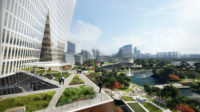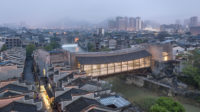Political unrest and sporadic violence on highways and roads in Bangladesh provided the backdrop to a three-day architectural conference in the country’s capital, Dhaka, in mid-January. Organized by the Bengal Foundation, a private trust dedicated to promoting the arts in Bangladesh, the event brought together speakers such as Fumihiko Maki, William J.R. Curtis, and Ken Yeang to examine how notions of “place” and “presence” shape the built environment. Other participants included architects Héctor Fernández Elorza from Spain, John Lin from Hong Kong, Anupama Kundoo from India, and Palinda Kannangara from Sri Lanka, and landscape architect Kongjian Yu from China, among others.
Although the conference was not affected by the political turmoil, it took place while Bangladesh’s top opposition leader was being held in virtual house arrest and opposition activists were trying to impose an embargo on deliveries to the capital city. In the first two weeks since the call for an embargo was made on January 5, at least 23 people had been killed, mostly by fire bombings of buses and vehicles on highways leading to Dhaka.
Undeterred, nearly 2,400 people each day—mostly architects and students—attended the free conference, called EngageDhaka. Architect Kashef Mahboob Chowdhury, who runs the Dhaka firm Urbana, served as director of the event, which was the Bengal Foundation’s first major foray into architecture. The organization, which is headed by businessman and art collector Abul Khair, publishes magazines and books on the arts and runs an annual Indian classical music festival that draws up to 60,000 people. It hopes to mount the architecture conference on an annual basis too.
At EngageDhaka, Khair announced the establishment of the Bengal Institute for Architecture, Landscapes, and Settlements, a multidisciplinary program that will start in August and be directed by architect and educator Kazi Khaleed Ashraf, who comes from Bangladesh and is currently teaching at the University of Hawaii. “We need a new kind of urbanism,” said Ashraf about Dhaka, a mega-city of 15 million people that sits at the mouth of an enormous delta fed by the country’s 700 rivers. “The challenge for designers will be to accommodate urban growth without harming the city’s landscape and hydrology,” said Ashraf. “Form follows flow,” he noted. Emphasizing the connection between the city and the countryside, Khair told the audience, “As an architect, you must go out to the villages and be a villager.”
In addition to the official topic of place and presence, a recurring theme of many of the 14 presentations was the impact of climate change, a critical issue in a country of nearly 160 million people living mostly at sea level and threatened by rising oceans. Kongjian Yu, who heads the Chinese landscape architecture firm Turenscape and will serve on the faculty of the new Bengal Institute, stated, “Landscape architecture is about survival. It’s about infrastructure, planning, food, water, and cultural identity.” His point was underlined by a freak hailstorm the night before the last day of the conference, an almost unheard of weather event for Dhaka in the usually dry month of January.
Likening the built environment to a prosthetic attached to a host organism—in this case, Earth’s biosphere—architect and ecologist Ken Yeang said architects’ job was to successfully integrate their projects with the natural systems that support the planet. He described the various strategies he has used in his buildings and planning projects to make this bio-integration happen. “Good design must be functional and livable, but ultimately, it must make people happy,” he said.
Anupama Kundoo, who practices in India and teaches in Madrid and Ithaca, NY, gave the most personal talk at the conference, which she titled “Uprootedness and the Sense of Place.” Though she was born in India, her family comes from Dhaka and moved to India before with the partition of India and Pakistan in 1947. The morning before her talk, Kundoo visited for the first time the house her grandparents had left seven decades ago. She showed an old black-and-white photograph of the imposing mansion in the 1930s and then a color shot of the ruined building today.
In his presentation, Maki outlined “a humane approach to architecture” and showed a series of projects, including his MIT Media Lab of 2009 and his recently completed 4 World Trade Center in New York City. But he started the talk with a 1997 project, the Kaze-no-Oka Crematorium in Oita Prefecture in Japan. “Sometimes the role of the architect is to reveal the hidden needs of a society,” he said. In the case of the crematorium, this was to provide “a dignified place to say farewell to a loved one.”
Madrid-based Héctor Fernández Elorza, whose work was published in Record’s Design Vanguard in 2013 [link to story], spoke about architecture as a “love affair with the earth and the sky.” His projects—which include a pair of buildings at the University of Alcalá near Madrid, a park in Zaragoza, and a sailing school in Cádiz—often exploit the tension between the heaviness of the earth and the lightness of the sky to create a sense of place.
John Lin, whose firm Rural Urban Framework (RUF) operates out of the University of Hong Kong and was also featured in the 2013 Design Vanguard [link to story], said RUF works as “an architectural NGO,” collaborating with local governments, residents of villages and small towns, and donors. “We make small-scale projects in response to large-scale problems” such as the need for housing, schools, and community facilities in parts of western China rocked by earthquakes in recent years.
Palinda Kannangara is another architect exploring the possibilities of architecture on a small scale. Based in Colombo, the capital of Sri Lanka, which has just a thousand architects, Kannangara said he “seeks simplicity” in his projects. For a house in Gingathhena, for instance, he used a vocabulary of steel, glass, and stone to create a modern—and elegant—bungalow. For a 27-room hotel near a waterfall, he cantilevered the structure over a steep slope to provide dramatic views of the valley below.
The interplay of place and presence was addressed by architectural historian William J.R. Curtis in his talk on the most famous building in Dhaka, Louis Kahn’s National Assembly. Designed for the regional capital of East Pakistan in the early 1960s and finally opened in 1982 as the parliament of the country of Bangladesh, the building “represents the concept of governance, independent of parties and politics,” said Curtis. A citadel-like structure of huge concrete cylinders and boxes fronting on a man-made lake, it “looks massive, but it floats. It seems to be a fortified structure, but dissolves in light,” he asserted. Kahn was “in a dialogue, even a bit of a competition,” with Le Corbusier, influenced by the older architect’s work in Chandigarh and Ahmedabad, India, stated Curtis. He was also “in a dialogue with history,” informing his building in Dhaka with what he learned from Bengal’s early Buddhist temples, its Mughal tombs, and even American grain silos. “He had an incredible ability to interpret the most powerful precedents of the past.”











Post a comment to this article
Report Abusive Comment